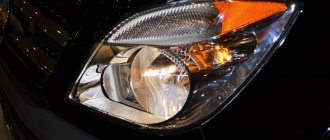Friends, we bring to your attention a very good article from the magazine BEHIND THE DRIVE (July 2018). Author Kirill Mileshkin, photo: Georgy Sadkov. Source: m.zr.ru
We are checking whether it is worth spending money on altering the headlights of a used car, the “vision” of which has been affected by age and mileage.
New light sources - xenon, LEDs, matrix technology - have brought automotive lighting to a fundamentally new level. But what good are the good intentions of an engineering genius if they simultaneously add problems to car owners? The plastic lenses of the headlights become cloudy, the lenses burn out - and after five years (and sometimes even earlier), the effectiveness of the headlights noticeably sags. At the age of seven years, some cars go completely “blind”, despite their sophisticated interior. So what should I do?
Glasses prescription
Medicines for the treatment of automobile vision are known: replacing lamps, restoring lenses, polishing lenses. All means simultaneously provide the maximum effect, but not everyone decides on such therapy, preferring to limit themselves to half measures. Replacing the headlight assembly is a solution for the strong-willed, because the prices for xenon and LED lighting equipment will make even people with solid incomes howl. Therefore, we decided to check what a compromise option that is gaining popularity provides - installing LED lens assemblies. This is noticeably cheaper than buying a pair of headlights.
No, no, we do not promote “collective farm” tuning, when xenon or LED lamps are installed in halogen optics! As our numerous tests have shown (ZR, No. 5, 2018), nothing good will come of this idea, and such tuning cannot be included within the framework of the law.
| Standard bi-xenon | Standard halogen |
| Standard Bi-LED | Bi-LED lenses Luma |
It's about something else. We tested Luma Bi-LED lenses that meet the requirements of UNECE Regulation 112-01, paragraph 6.2.4 “Measurement of low beam headlight illumination”.
Lens assemblies are relatively easy to implant into headlights. Manufacturers of tuning lenses adapt seats to standard elements. The module can also be integrated into reflective optics. It is now more correct to call the diffuser simply a protective cap, since in modern headlights it does not participate in the formation of the beam - the lens is responsible for this. So the biggest difficulty is to disconnect the diffuser from the body for work, since modern optics are made non-separable.
Penalty for LED headlights
A penalty may be imposed if diode equipment is detected in headlights that are designed only for halogen. That is, with normal light distribution and brightness, the chances that an inspector will examine the lamps are small. But nevertheless, if LEDs are used in a structure intended for them, a fine of 500 rubles .
The law does not provide for other penalties, so even if a violation is repeatedly detected, the punishment will not change. Now deprivation of rights can only be for the installation of non-standard xenon ; LEDs no longer belong to this category.
LEDs in headlights that are not designed for them are punishable by a fine.
Convalescent ward
We spent a long time selecting a group of test cars for comparative tests at the test site. We settled on the popular Mazda CX-5 crossover - not only because it is in the top 25 of the market, but also based on information from alternative light installers: they claim that owners of cars of Japanese and Korean brands are more likely to seek such modifications than buyers German cars. But, of course, you can install lenses in almost any model.
The core of the test group consisted of three first-generation CX-5s. The focus is on a car with Luma Bi-LED lenses integrated into the standard headlights. Along with it are the same cars with untouched factory lights: one with simple halogens, the second with bi-xenon. The company they chose was simply perfect: all three were manufactured in 2012–2013, with a mileage of 66,000–67,000 km. This means that the headlight lenses of these cars are battered by life to approximately the same extent.
We have not modified Mazdas with halogen and xenon in any way. They perform with the original lamps, which have worked without replacement since the moment the cars were purchased from the dealer, and with the original lenses, which are no longer the most transparent. This is the essence of our test - to compare the standard light, which has worn out over the years, with an alternative one that anyone can install.
The fresh second-generation CX-5 with standard LED headlights was invited to serve as the ideal reference car. All cars were checked in advance to ensure that their headlights were correctly adjusted.
It is difficult to carry out the test without a reflective vest. The meter transmits the recorded values via radio, but visual control of its movements is necessary for correct filling.
Light vs Dark
Work at the test site begins as usual. While the photographer is looking for good angles in the gathering twilight, the team is placing a grid of cones on the asphalt. The distance between them is 10 meters. At each pole we will measure the illumination given by the headlights of each car with a lux meter, and based on the measurement results we will draw the light beams of each headlight. We draw the line between light and darkness based on the illumination value of one lux - everything below this value is perceived as darkness from the driver’s seat.
Mazdas with halogen and xenon in low beam mode performed predictably: the range is not the most impressive. The light “ran out” at about 70 meters. Pay attention to the difference in the shape of the beam: with gas-discharge optics it is more shifted towards the right side of the road.
If both cars were new, the superiority of xenon would be more impressive. His lamps already noticeably decrease in brightness by the age of three, and our experimental CX-5 was five years old. It is for this reason that gas-discharge lamps are recommended to be replaced in pairs. This does not happen with halogens.
As soon as the crossovers with LED lamps reached their starting position, the cone “walker” had more work to do. The car with standard lights reached the 150-meter mark. And the LED lenses we installed in the fourth car exceeded this achievement by 40 meters! Don’t rush to accuse them of being merciless towards the eyes of oncoming drivers: the farthest illuminated cones, according to the light meter readings, are located on the two lines to the right in the direction of travel - in fact, on the right side of the road and on the side of the road.
LED lamps for lensed headlights H1 Round Light 12 CSP set - 2 pcs.
LED lamps for lensed headlights.
Peculiarities:
- Glow over the entire surface of the rod at 360 degrees;
- Vacuum heat removal technology;
- Thin light part, compact body and driver - easy installation;
- 12 powerful CSP chips.
Round Light LED lamps use heat removal technology based on vacuum infusion. The device uses a hollow tube filled with a special liquid. At one end of the tube there are LEDs, and at the other there is a heatsink. During operation, the LEDs heat the tube and the liquid evaporates. It condenses at the other end in a colder area, effectively removing heat to the radiator with a fan. This technology dissipates heat much better than a solid copper rod.
For most LED lamps, the LEDs are located on opposite sides of the housing. This arrangement works well in reflector headlights, where the sides of the reflector participate in the formation of the light beam. In lenses, the beam is formed by the entire surface of the reflector, and when such lamps are installed, a dark zone appears in front of the car. Round Light LED lamps have 12 CSP chips, arranged in threes on four sides around a thin heat sink. This gives an even glow all around without dark areas. After installing the lamp into the lens, your optics will maintain the normal light distribution in the beam.
The LED chips in the lamp are as close as possible to the focusing point of conventional standard lamps. Consuming less electricity (20 W versus 55 W halogen), they produce 2 times more intense light output - that’s 2700 Lumens from each lamp.
The device is equipped with a powerful but compact fan; all diodes are securely mounted on a copper board, which is located on the tube. The durable aluminum body is lightweight and resistant to oxidation.
The model is designed for lensed low beam and fog headlights.
Installation instructions:
- Remove the standard light bulb and disconnect the wiring.
- For bases H8, H9, H11, HB3, HB4. Insert the lamp into the headlight and connect the standard wiring.
- For bases: H1, H7. Disconnect the base from the LED lamp by turning and pulling it towards you. Install the LED lamp base into the headlight and secure it.
- Connect the LED lamp wiring to the connector.
- Secure the controller and wires using the fasteners included in the kit.
- Be sure to adjust the headlights (preferably at a special stand in the service center).
Attention! When using lamps in headlights without covers, the warranty does not apply.
Dimensions:
Characteristics:
- Marking: H1
- Base type: P14.5s
- Controller dimensions: 45 x 22 x 18 mm
- Operating voltage: 10-30 Volts
- Power consumption per lamp: 20 Watt
- Equivalent luminous flux of LED lamp: 2700 lumens*
- Color temperature: 5000K
- Waterproof: IP65
- Weight of one lamp with block: 87 g
- Operating temperature: from -45°С to +55°С
- Number and type of LEDs: 12 x CSP
- Dimensions of the light part: 40 x 9 mm
- Tail dimensions: 34 x 34 mm
- Materials: copper, aluminum, plastic
- Service life: 10000 hours
- Warranty: 1 year
- Manufacturer: China
Equipment:
- 2 x LED lamps
- 2 x Controllers
- Mounting kit
It’s very easy to order LED lamps for lens headlights H1 Round Light 12 CSP set - 2 pcs in the Electro-kot online store - just click on the add to cart button, fill out the required fields and select a convenient delivery method.
Please note that we do not guarantee 100% compatibility of lamps with your vehicle. In rare cases, the lamps may not work correctly. The built-in snag is not capable of bypassing all on-board computers. This is not a warranty event and the lamps can be returned to the store as unsuitable goods. Also, to bypass the demanding BC, we recommend equipping the lamps with a special blende: Decoys for LED lamps
Low beam comparison
In the photo on the left: Light distribution diagram: low beam.
Directly in front of the car and to the left, where there is a chance of blinding oncoming people, the factory LED headlight shines even more than the tuning one. For example, on the left center line at a distance of 60 meters from the car, in the first case we measured two luxes, and in the second - one. Interestingly, for the human eye the picture is different. This can be seen in the photographs: the non-original LED headlights shine brighter and more evenly than the stock ones. The advantages of standard ones include a wider beam at a short distance from the bumper, which helps when maneuvering on unlit roads at low speeds.
Having studied the measurement protocols in the low beam mode, we already guessed what to expect from the high beam: in most cases, the established hierarchy is preserved. This is what happened in the dispute between cars with LED optics. The second generation CX-5 reached up to 240 meters with its LED light, the old car with installed LED lenses - up to 280 meters. In both cases, this is an excellent result with which you can feel confident on the track.
The halogen light “shot” further than xenon: a quarter of a kilometer versus 220 meters. In addition to the already mentioned reduction in the brightness of gas-discharge lamps, another factor played a role. In a simple Mazda, low beam and high beam operate from different lamps. The second one rarely comes into play, and its reflex section is ideally preserved for many years. And the xenon light on the CX-5 comes from one lamp and through one lens. That is, the resource of the lamp and lens is consumed mostly by the low beam, but at the same time the high beam also suffers. Here is the result: a Mazda CX-5 driven with halogen lights gave a more effective high beam.
Each Luma Bi-LED module contains six LEDs. Each is covered with a personal miniature lens plus one larger common one. All light sources work constantly. Switching between low beam and high beam occurs using a movable curtain. The modules are equipped with a mount adapted to the popular Hella and Koito lenses, making replacement easy.
Luma Lens Research Results
| Dot | Class B, normal, cd | Result, cd | Conclusion |
| B50L | ≤ 350 | 288,6 | corresponds |
| 75R | ≥ 10 100 | 58 172,0 | corresponds |
| 50R | ≥ 10 100 | 53 538,0 | corresponds |
| 50V | ≥ 5100 | 57 310,3 | corresponds |
| Zone III | ≤ 625 | 276,2 | corresponds |
Technical characteristics of Bi-LED modules
| Technical characteristics of Bi-LED modules | |
| Luminous flux (high beam, per module) | 2780 lm |
| Luminous flux (low beam, per module) | 1750 lm |
| Power | 44 W |
| Colorful temperature | 5700 K |
| Life time | 100,000 h |
| Guarantee | 6 years |
conclusions
After riding for several days, I came to the following conclusions:
- the light from LED lamps installed in the lens is slightly inferior to xenon;
- diode lamps are ideal for installation in fog lights or in a regular small reflector.
I hope that affordable, more powerful diodes will appear in the near future. Then it will be possible to replace all the light bulbs with LEDs. At the moment, I decided for myself: the lenses need xenon, and the fog lights and high beams need LED lamps.
Off to surgery!
In the photo on the left: Light distribution diagram: high beam.
In the case of the Mazda CX-5, the progress of optics corresponds to the theory: xenon is better than halogen, but worse than LEDs. Years quickly leave their mark on the headlights - the lenses of all three first-generation cars we took needed polishing. In other words, it would be useful for owners to think about improving the head optics.
I must admit, the quality of the road illumination amazed me with the quality of the non-standard lenses. They significantly surpassed halogen and xenon, which worked for 70,000 km. The difference is obvious. The light characteristics of headlights with such lenses are in some ways even better than those of the more sophisticated and modern lighting technology of next-generation cars. If you value excellent light and are not bothered by the cost of rework (from 15 to 30 thousand rubles), replacing lenses will be an excellent way to restore “vision” to your car.
What is LED
Pros of LEDs
The absence of a filament and moving parts makes it reliable and resistant to mechanical stress; there is almost nothing to break. In addition, they are not afraid of low temperatures. The first generations of LEDs had a weak luminous flux. Nowadays third generation diodes are used. If they have a special stabilization unit (driver), they are capable of emitting a luminous flux almost equal to xenon. The energy consumption of LEDs is lower than that of xenon or halogen, which means there is virtually no load on the generator. Installation of diode lamps is simple and does not require modifications to the headlight. They come in all sizes - from H1 to H11, and the driver unit fits inside the case. The light bulb replaces the standard one; you just need to bite off the power connector and connect it to the wire going to the block.











